Analysis of Parkinson Speech
 |
||
| Contents: | ||
Morbus Parkinson is a wide spread disease especially in the age group above 50 years. Besides several motor disorders also speech disorders accompany this disease. The dysarthria expresses itself, among other symptoms, by a too low speech level and a mumbling voice. Probably due to a perception disorder, the patients do not realize their dysfunction in speech production.
 While the motor disorders can already be treated well with different methods, like medical treatments or deep brain stimulation, the speech disorders are still not fully understood and difficult to treat. Besides this, the treatment of the motor defects often even worsens the speech disorder. Since the perception disorder, causing the dysarthria, is difficult to treat, there exist several approaches of speech therapies that try to improve the speech production of the patients. These therapies differ in the ideas of how to improve the patients speech. The success is dependent on the individual patient.
While the motor disorders can already be treated well with different methods, like medical treatments or deep brain stimulation, the speech disorders are still not fully understood and difficult to treat. Besides this, the treatment of the motor defects often even worsens the speech disorder. Since the perception disorder, causing the dysarthria, is difficult to treat, there exist several approaches of speech therapies that try to improve the speech production of the patients. These therapies differ in the ideas of how to improve the patients speech. The success is dependent on the individual patient.
The investigation of the efficacy of these therapies has been and is still a very interesting research topic. In contrast, not yet established is the investigation of the origin and location of the problem in speech production. This would help to adapt the speech therapy to the specific needs of the individual patient. This can be realized by an evaluation of the patient’s speech using technical measures. Further, these measures can be used instead of auditive assessments to classify the severity of the patients dysarthria.
The goal is the development of a tool that is capable to perform such analyses. It includes the recording equipment that is needed to make reliable recordings of the patients, as well as a recording environment, implemented in a real-time signal processing toolkit, measures to evaluate the speech disorder, and, finally, the verification of the selected measures.
 The hardware components should be simple to use and transport. Since one common symptom of Parkinson's disease is the tremor, the patients are moving during a recording session, such that the signal level is changed and level-based measures are not applicable anymore. Thus, a microphone array is needed to provide level-correct speech recordings.
The hardware components should be simple to use and transport. Since one common symptom of Parkinson's disease is the tremor, the patients are moving during a recording session, such that the signal level is changed and level-based measures are not applicable anymore. Thus, a microphone array is needed to provide level-correct speech recordings.
To realize the level-correct recordings, an algorithm for speaker localization should be included in the recording environment. Besides, the analysis the system has the task to lead the patients through the recording session in an easy way. Finally, the evaluation of the recordings using technical measures is done. Therefore, newly developed measures as well as known measures like the vowel-space area, the A-weighted signal level, and the tube model of the human vocal tract can be used to locate the problem of speech production in the vocal tract.
To complete the speech-disorder analysis, also EEG recordings are necessary to perform a source analysis of the EEG recordings taken in parallel to the speech recordings and observe activity changes in different brain regions. These findings should then be related to the results of the speech analysis.
Corresponding Publications:
P. Fuchs, K. Krüger, G. Schmidt: Parkinson’s Disease Speech Analysis – Machine-Learning-based Evaluation of Speech Impairments, Proc. DAGA, Hamburg, Germany, 2023
J. Winter, K. Krüger, P. Piepjohn, G. Schmidt: Objective Measures for Speech Evaluation, Biosignale Workshop, 2022, Dresden, Germany
A. Baumann, A. Nebel, O. Granert, K. Giehl, S. Wolff, W. Schmidt, C. Baasch, G. Schmidt, K. Witt, G. Deuschel, G. Hartwigsen, K. Zeuner, T. van Eimeren: Neural Correlates of Hypokinetic Dysarthria and Mechanisms of Effective Voice Treatment in Parkinson Disease, Neurorehabilitation and neural repair, Vol. 32, Nov. 2018
F. Spitz, C. Baasch, G. Schmidt, U. Heute, A. Nebel, G. Deuschl: Hörgeräte-basierte Parkinson-Sprachanalyse, Proc. DAGA, Germany, 2018
C. Baasch, G. Schmidt, U. Heute, A. Nebel, and G. Deuschl: Parkinson-Sprachanalyse - Erweiterungen zum Qualitätsmerkmal Formantdreieck, Proc. DAGA, Kiel, Germany, open access, 2017
C. Baasch, G. Schmidt, U. Heute, A. Nebel, G. Deuschl: Parkinson-Speech Analysis: Methods and Aims, ITG Speech, October 2016
C. Baasch, W. Schmidt, G. Schmidt, U. Heute, A. Baumann, A. Nebel, G. Deuschl, T. von Eimeren: Stimmtherapie für Parkinsonsprache: Akustische Analyse der Wirksamkeit, ESSV 2016, Leipzig, Germany
L. Jaschke, C. Baasch, G. Schmidt, A. Nebel, G. Deuschl: Level-correct Speech Recordings for the Analysis of Parkinson Speech, DAGA 2016
A. Baumann, G. Hartwigsen, A. Nebel, S. Wolff, W. Schmidt, C. Baasch, G. Schmidt, G. Deuschl, K. E. Zeuner, and T. van Eimeren: Neural effects of Lee Silvermann Voice Treatment in Parkinson`s disease (Poster), Congress of the European Academy of Neurology, 2015, Berlin, Germany
M. Muthuraman, A. Hossen, U. Heute, G. Deuschl, J. Raethjen: A New Diagnostic Test to Distinguish Tremulous Parkinson's Disease from Advanced Essential Tremov, Movement Disorders, 26, 2011

 On behalf of the members of the Chair of Digital Signal Processing and System Theory, we would like to take this opportunity to wish you all a very Merry Christmas and a peaceful, restful winter break. We hope that this festive season brings you joy, relaxation, and cherished moments with your loved ones.
On behalf of the members of the Chair of Digital Signal Processing and System Theory, we would like to take this opportunity to wish you all a very Merry Christmas and a peaceful, restful winter break. We hope that this festive season brings you joy, relaxation, and cherished moments with your loved ones.